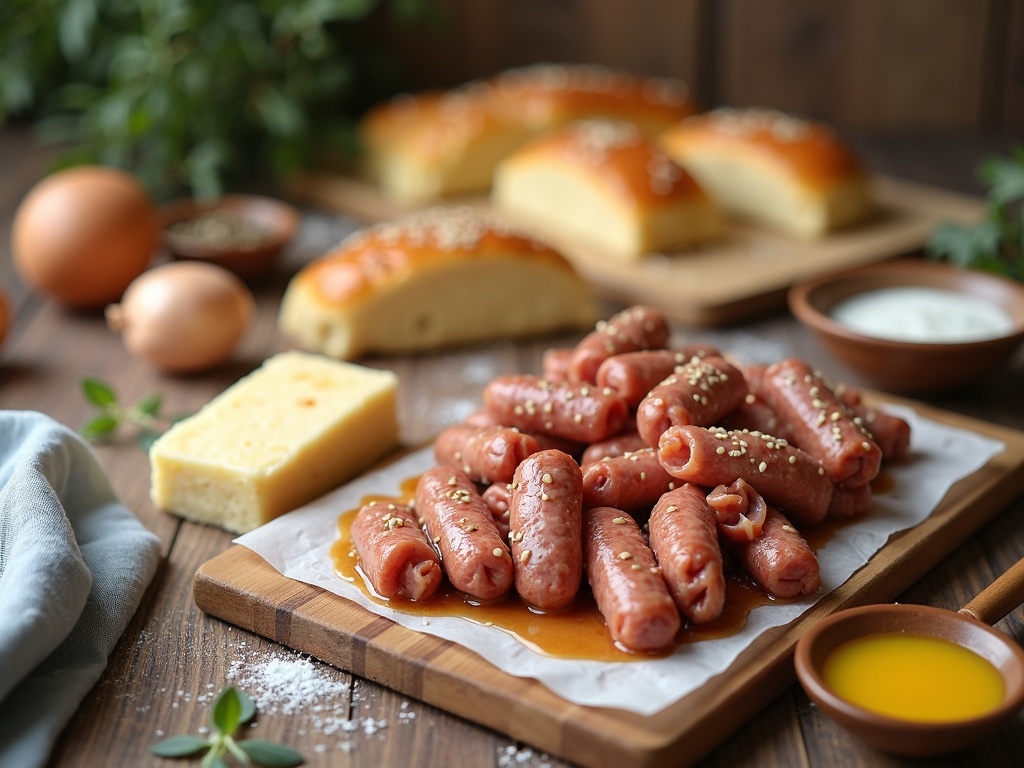The Sausage roll recipe has transformed from a classic British snack into a global phenomenon worth over $1.1 billion in 2021, with steady growth expected at 3.7% annually through 2028. This straightforward yet captivating mix of seasoned sausage meat wrapped in flaky puff pastry delivers the ideal combination of rich, savory filling and crisp exterior that can be adapted with different meats, spices, and local flavors.
Find In This Article
Key Takeaways
- Creating homemade sausage rolls requires just a few essentials: ready-made puff pastry, quality sausage meat, herbs like thyme and sage, and an egg wash for that signature golden finish.
- The preparation process is straightforward—rolling pastry to 3mm thickness, adding seasoned meat, sealing the edges, and baking at 200°C for 20-25 minutes until golden brown.
- Healthier alternatives include using leaner meats like chicken or turkey, incorporating whole grain pastry, adding vegetables to the filling, or creating plant-based versions.
- Traditional sausage rolls contain 300-400 calories per 100g serving with 10-12g of protein and 20-25g of fat, making portion control important.
- For the complete experience, serve with condiments like mustard or HP Sauce and pair with sides such as pickles, fresh salads, or potato wedges for a more substantial meal.
The Ultimate British Snack: A History of Sausage Rolls
Sausage rolls have deep roots in British culinary tradition, earning their place as a beloved snack across the United Kingdom. These savory pastries have captured hearts and taste buds for generations, appearing at everything from casual picnics to elegant parties. The concept is brilliantly simple – seasoned sausage meat encased in golden, flaky puff pastry that creates the perfect handheld treat.
Rise in Global Popularity
The humble sausage roll has transformed from a local favorite to an international sensation. The global sausage roll market reached an impressive $1.1 billion in 2021, showing just how far this British classic has traveled. Market analysts project continued growth at a steady 3.7% CAGR between 2022 and 2028, proving these savory treats aren’t just a passing trend but a food staple with staying power.
I’ve noticed sausage rolls gaining popularity beyond traditional British establishments, appearing in bakeries and cafés worldwide with exciting regional variations. Some cultures add local spices or substitute different meats while maintaining the essential pastry-wrapped concept.
The Perfect Combination
What makes sausage rolls so irresistible is the perfect marriage of textures and flavors. The traditional recipe combines high-quality sausage meat with flaky, buttery puff pastry. This creates a beautiful contrast between the rich, savory filling and the light, crisp exterior.
For the best experience, sausage rolls should always be served warm. The heat enhances the aromatic spices in the meat and maintains that delightful crispness of the pastry. While they can certainly be enjoyed cold, warming them slightly brings out their full flavor potential.
If you’re looking to explore more savory comfort foods, sausage casserole recipes offer another delicious way to enjoy these flavors in a heartier format.
The versatility of sausage rolls makes them perfect for numerous occasions:
- Afternoon tea accompaniments
- Party finger foods
- Quick lunch options
- Picnic essentials
- Holiday gathering staples
With their convenient size, delicious taste, and ease of preparation, it’s no surprise that sausage rolls have maintained their popularity for generations. They represent the perfect balance of simplicity and satisfaction that defines great comfort food.

Everything You Need to Make Perfect Sausage Rolls
I’ve found that creating delicious sausage rolls at home is surprisingly straightforward once you have the right ingredients on hand. The beauty of this classic snack lies in its simplicity, combining flaky pastry with savory filling that can be customized to your taste preferences.
Essential Ingredients
The foundation of any great sausage roll starts with quality pastry and filling. Here’s what you’ll need:
- 500g ready-made puff pastry
- 500g sausage meat (traditional, chicken, or plant-based alternatives)
- 1 tsp salt
- 1 tsp pepper
- 1 tsp thyme
- 1 tsp sage
- 1 egg mixed with 1 tablespoon milk (for glazing)
- Optional: 1/2 cup chopped onion or garlic for extra flavor
For the pastry, I’ve learned that ready-made puff pastry offers incredible convenience without sacrificing quality. It comes in both block and sheet forms, with the latter saving you the step of rolling it out. The pastry should be cold but pliable when you work with it.
The filling is where you can get creative. Traditional pork sausage meat provides a rich, juicy interior, but chicken sausage meat offers a lighter alternative. For those preferring plant-based options, several excellent vegan sausage alternatives are available that mimic the texture and flavor profile of meat remarkably well.
The seasonings I’ve listed create a classic flavor profile, but don’t be afraid to adjust them to your preference. Fresh herbs will provide a more vibrant flavor than dried, though both work perfectly fine.
Store-Bought vs. Homemade Pastry
I’m often asked about the difference between store-bought and homemade pastry for sausage rolls. While making puff pastry from scratch is certainly an achievement, it’s also time-consuming and technically challenging.
Store-bought puff pastry has come a long way in quality and typically produces consistently excellent results. The layers are uniform, and the butter content is well balanced, giving you that characteristic flaky texture. Most home cooks (including professional chefs!) rely on quality ready-made pastry for this very reason.
If you do opt for homemade, you’ll have complete control over the ingredients and can customize the fat content. Some bakers prefer using a mix of butter and lard for extra flakiness. The homemade version might have a slightly more rustic appearance and potentially more flavor depth, but requires significantly more time and skill.
The egg wash is non-negotiable regardless of your pastry choice. This simple mixture of beaten egg and milk creates that irresistible golden-brown finish and helps seal the edges of your pastry. For extra visual appeal, you can sprinkle sesame seeds or poppy seeds on top after glazing.
If adding onions or garlic to your meat mixture, I recommend sautéing them lightly first to mellow their flavor and remove excess moisture that could make your pastry soggy.
For a complete meal, these sausage rolls pair wonderfully with a hearty sausage casserole for dinner or lunch gatherings.
Remember that the quality of your sausage meat significantly impacts the final result. If possible, visit a good butcher for freshly ground meat with an ideal fat content of about 20% for juiciness without excessive greasiness.

Step-by-Step Sausage Roll Magic
Creating perfect sausage rolls at home is simpler than you might think. I’ve perfected this recipe through years of testing, and I’m excited to share my foolproof method with you. Follow these steps for delicious results every time.
Preparation and Assembly
First, preheat your oven to 200°C (400°F) to ensure it reaches the optimal temperature for that signature golden crust. While the oven heats up, I like to prepare my workspace by lightly dusting a clean surface with flour.
Roll out your pastry to about 3mm thickness. The thin, even pastry is key to getting that perfect flaky texture. Once rolled, create a line of sausage meat along one edge of the pastry, leaving enough room to fold and seal.
For extra flavor, consider adding these aromatic ingredients to your sausage mixture:
- Finely diced onions for sweetness
- Minced garlic for depth
- Fresh herbs like thyme or sage
- A pinch of nutmeg or allspice
After placing your meat mixture, carefully fold the pastry over to encase the filling. Using a fork, press down along the edge to create a tight seal – this prevents any filling from escaping during baking.
Cut your long sausage roll into smaller pieces, about 5cm each for party-sized bites. For the finishing touch, brush each piece with egg wash to achieve that irresistible golden shine.
Place your sausage rolls on a baking sheet and pop them into the oven for 20-25 minutes. You’ll know they’re done when the pastry has puffed up beautifully and turned a rich golden brown color.
For maximum puff, make sure your pastry is cold when it hits the hot oven – this temperature contrast creates those beautiful flaky layers. I sometimes chill my assembled rolls for 15 minutes before baking.
Allow your sausage rolls to cool for at least 10 minutes before serving. This cooling period lets the pastry set and the flavors meld together perfectly.
The beauty of this recipe is its versatility. You can prepare these rolls ahead of time and freeze them unbaked, then cook them straight from frozen when needed – just add a few extra minutes to the baking time.
Know Your Nutrition
When making sausage rolls at home, I always keep an eye on the nutritional content. Traditional sausage rolls pack quite a caloric punch, typically containing 300-400 calories per 100g serving. This means a standard-sized sausage roll could easily contribute a significant portion of your daily calorie intake.
The protein content in sausage rolls is relatively decent, providing approximately 10-12g per 100g serving. This protein comes primarily from the meat filling, which helps make sausage rolls more satisfying than some other pastry snacks.
Macronutrient Breakdown
The carbohydrate content in sausage rolls typically ranges between 25-30g per 100g serving. Most of these carbs come from the pastry casing, which is usually made with refined white flour. The fat content is where sausage rolls get their rich flavor, containing about 20-25g of total fats per 100g, with saturated fats accounting for 8-10g of that amount.
These numbers might seem concerning if you’re watching your intake, but there’s good news. I’ve found several ways to create healthier versions without sacrificing the delicious taste that makes sausage rolls so popular.
Healthier Alternatives
I’ve experimented with several modifications to create more nutritious sausage rolls:
- Substituting traditional pork sausage meat with leaner options like chicken or turkey sausage can reduce the fat content significantly
- Using whole grain pastry instead of traditional puff pastry adds fiber and reduces refined carbohydrates
- Adding finely chopped vegetables to the meat mixture increases the nutrient density
- Experimenting with plant-based fillings using beans, lentils, and mushrooms for vegetarian options
- Using an air fryer instead of traditional baking methods can reduce the need for additional oils
When comparing traditional recipes to these modified versions, the nutritional improvements are substantial. A standard pork sausage roll might contain up to 25g of fat per 100g, while a lean chicken version with whole grain pastry could contain as little as 12-15g. The fiber content in modified recipes can also increase from barely 1g to 3-4g per serving.
I find the taste difference is minimal when properly seasoned, especially when incorporating herbs and spices to enhance flavor without adding calories. For an especially delicious option that balances nutrition and taste, my sausage casserole flavors can be adapted into a sausage roll filling that’s both nutritious and delicious.
The protein quality also improves when using leaner meats or adding legumes to vegetarian versions. While traditional sausage rolls rely heavily on processed meats that nutrition experts often recommend limiting, homemade versions allow for better quality ingredients and control over what goes into your food.
Remember that portion size matters tremendously with sausage rolls. Even with healthier modifications, they remain a relatively calorie-dense food. I find that serving smaller rolls alongside a vegetable-rich salad creates a more balanced meal that satisfies without overloading on calories.
By understanding the nutritional profile of sausage rolls and making thoughtful modifications, you can enjoy this classic treat while still maintaining a balanced approach to eating.
Perfect Pairings and Serving Ideas
When I serve sausage rolls, the right condiments and sides transform this simple pastry into a memorable meal. Traditional condiments like HP Sauce, mustard, and ketchup are classic companions that enhance the savory meat filling. I find that a sharp English mustard cuts through the richness of the pastry, while sweet chili sauce offers a modern twist for those seeking something different.
Complete Your Plate
Sausage rolls shine brightest when paired with thoughtfully selected accompaniments:
- Tangy pickles: Gherkins, pickled onions, or beetroot provide acidity that balances the richness
- Fresh salads: A simple coleslaw or crisp green salad adds texture and lightness
- Baked beans: For a heartier meal, especially popular with children
- Chips or potato wedges: When serving as a main course rather than a snack
- Chutney: Apple or tomato varieties complement the savory meat beautifully
Beverage pairings matter just as much as food. For adults, a cold beer—particularly an amber ale or lager—works wonders with the savory pastry. Non-alcoholic options like ginger beer, apple juice, or a classic cup of tea make excellent alternatives. For special occasions, I’ve found that sparkling apple cider creates a festive touch without overpowering the food.
Serving size depends entirely on the occasion. For a light lunch, I typically serve two medium-sized rolls per person with a side salad. At parties, bite-sized mini rolls work best—I prepare about 3-4 per guest. When featuring them as the main course for dinner, I’ll serve larger rolls (about 6 inches each) with multiple sides.
Presentation elevates even the simplest sausage roll. I arrange them on wooden boards for casual gatherings or white platters for more formal events. A light dusting of paprika or a sprinkle of fresh herbs like parsley adds visual appeal. For an impressive spread, I create a dedicated condiment station with small bowls of different sauces, allowing guests to customize their experience.
For the ultimate comfort food experience, try serving freshly baked sausage rolls alongside a hearty sausage casserole for those cooler evenings when something substantial is called for.
When serving kids, I often cut the rolls into smaller pieces and arrange them in fun patterns or alongside colorful vegetable sticks. This makes the meal more approachable and ensures they get some nutritional balance.
Remember that temperature matters—sausage rolls are at their best when served warm but not scalding hot. I typically let them rest for 5 minutes after baking before serving, which allows the filling to set slightly while keeping that delightful contrast between crisp exterior and hot filling.
For picnics or packed lunches, I wrap cooled sausage rolls in parchment paper rather than plastic wrap, which helps preserve the pastry’s texture. A small container of condiment on the side completes the portable package.
Don’t forget that leftover sausage rolls can be revitalized in a hot oven for 5-7 minutes—avoid microwaving if possible as this makes the pastry soggy rather than crisp.
Sources:
British Food History – “The History of the Sausage Roll”
MarketWatch Report 2022 – “Global Sausage Roll Market Growth Overview”
Healthline Articles on Snacks – “Nutritional Analysis of Popular Snack Foods”

